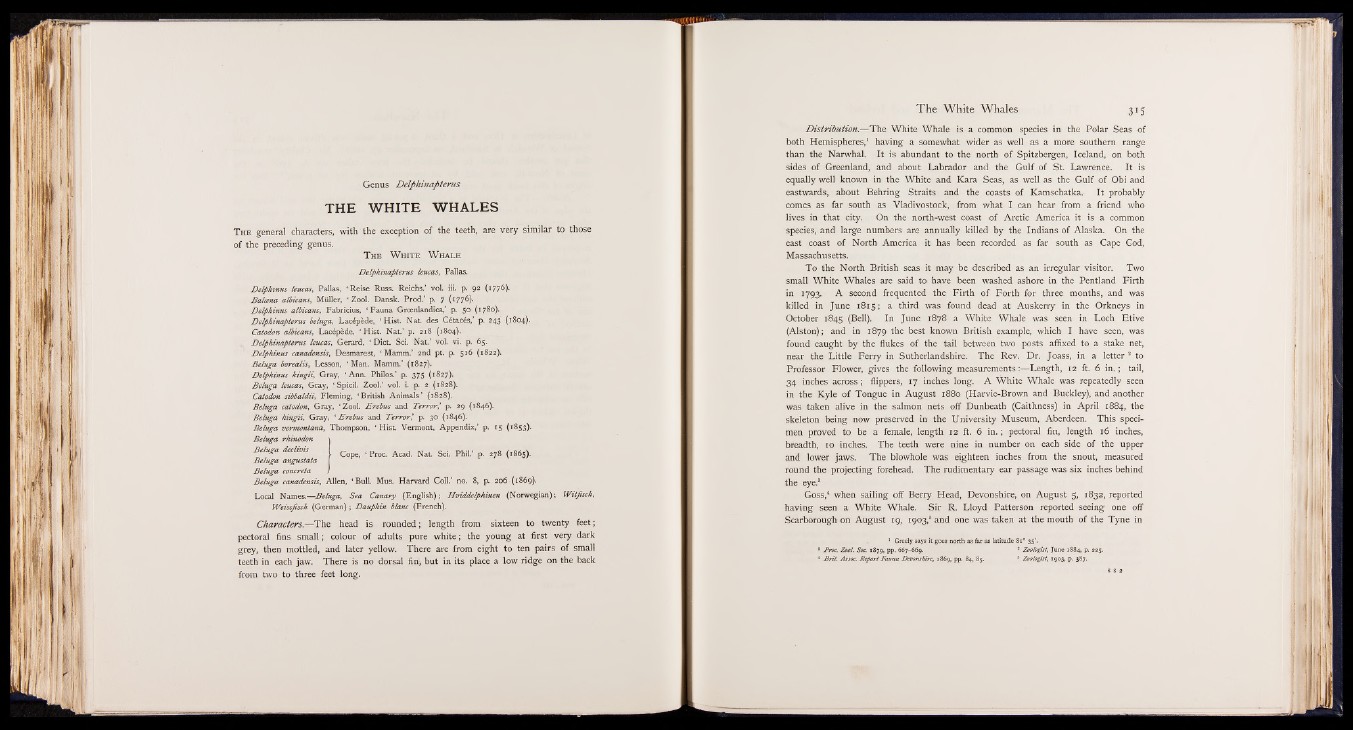
Genus Delphinapterus
T H E W H IT E W H A L E S
T he general characters, with the exception of the teeth, are very similar to those
of the preceding genus.
T he W hite W hale
D elphinapterus leucas, Pallas.
Delphm us leucas, Pallas, ‘ Reise Russ. Reichs.’ vol. iii. p. 92 (1776).
Baleena albicans, Müller, ‘ Zool. Dansk. Prod.’ p. 7 (1776).
D elphinus albicans, Fabricius, ‘ Fauna Groenlandica,’ p. 50 (1780).
Delphinapterus beluga, Lacépède, ‘ Hist. Nat. des Cétacés,’ p. 243 (1804).
Catodon albicans, Lacépède, ‘ Hist. Nat.’ p. 218 (1804).
Delphinapterus leucas, Gerard, ‘ Diet. Sci. Nat.’ vol. vi. p. 65.
D elphinus canadensis, Desmarest, ‘ Mamm.’ 2nd pt. p. (1822).
Beluga borealis, Lesson, ‘ Man. Mamm.’ (1827).
D elphinus k in g ii. Gray, ‘ Ann. Philos.’ p. 375 (1827).
Beluga leucas, Gray, ‘ Spicil. Zool.’ vol. i. p. 2 (1828).
Catodon sibbaldii, Fleming, ‘ British Animals’ (1828).
Beluga catodon, Gray, ‘ Zool. Erebus and Terror,’ p. 29 (1846).
Beluga k in g ii, Gray, ‘ Erebus and Terror', p. 30 (1846).
Beluga vermontana, Thompson, ‘ Hist. Vermont, Appendix,’ p. 15 (1853).
Beluga rhinodon
B eluga decltms c .p roc. Acad Nat Sci ph i). 2?8 ( l865).
B eluga angustata
Beluga concreta
Beluga canadensis, Allen, ‘ Bull. Mus. Harvard Coll.’ no. 8, p. 206 (1869).
Local Names.— Beluga, Sea Canary (English); H viddelphinen (Norwegian);
W eissfisch (German) ; Dauphin blanc (French).
W itfisch,
Characters.— The head is rounded; length from sixteen to twenty feet;
pectoral fins small; colour of adults pure white; the young at first very dark
grey, then mottled, and later yellow. There are from eight to ten pairs of small
teeth in each jaw. There is no dorsal fin* but in its place a low ridge on the back
from two to three feet long.
Distribution.— The White Whale is a common species in the Polar Seas of
both Hemispheres,1 having a somewhat wider as well as a more southern range
than the Narwhal. It is abundant to the north of Spitzbergen, Iceland, on both
sides of Greenland, and about Labrador and the Gulf of St. Lawrence. It is
equally well known in the White and Kara Seas, as well as the Gulf of Obi and
eastwards, about Behring Straits and the coasts of Kamschatka. It probably
comes as far south as Vladivostock, from what I can hear from a friend who
lives in that city. On the north-west coast of Arctic America it is a common
species, and large numbers are annually killed by the Indians of Alaska. On the
east coast of North America it has been recorded as far south as Cape Cod,
Massachusetts.
To the North British seas it may be described as an irregular visitor. Two
small White Whales are said to have been washed ashore in the Pentland Firth
in 1793. A second frequented the Firth of Forth for three months, and was
killed in June 1815; a third was found dead at Auskerry in the Orkneys in
October 1845 (Bell). In June 1878 a White Whale was seen in Loch Etive
(Alston); and in 1879 the best known British example, which I have seen, was
found caught by the flukes of the tail between two posts affixed to a stake net,
near the Little Ferry in Sutherlandshire. The Rev. Dr. Joass, in a letter 2 to
Professor Flower, gives the following measurements:— Length, 12 ft. 6 in .; tail,
34 inches across; flippers, 17 inches long. A White Whale was repeatedly seen
in the Kyle of Tongue in August 1880 (Harvie-Brown and Buckley), and another
was taken alive in the salmon nets off Dunbeath (Caithness) in April 1884, the
skeleton being now preserved in the University Museum, Aberdeen. This specimen
proved to be a female, length 12 ft. 6 in .; pectoral fin, length 16 inches,
breadth, 10 inches. The teeth were nine in number on each side of the upper
and lower jaws. The blowhole was eighteen inches from the snout, measured
round the projecting forehead. The rudimentary ear passage was six inches behind
the eye.8
Goss,4 when sailing off Berry Head, Devonshire, on August 5, 1832, reported
having seen a White Whale. Sir R. Lloyd Patterson reported seeing one off
Scarborough on August 19, 1903,6 and one was taken at the mouth of the Tyne in
. 1 Greely says it goes north as far as latitude 8i° 35'.
s Proc. Zool. Soc. 1879, pp. 667-669. 8 Zoologist, June 1884, p. 225.
* B rit. Assoc. Report Fauna Devonshire, 1869, pp. 84, 85. 5 Zoologist, 1903, p. 387.